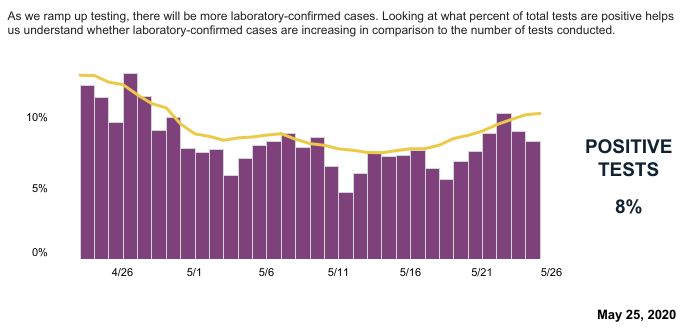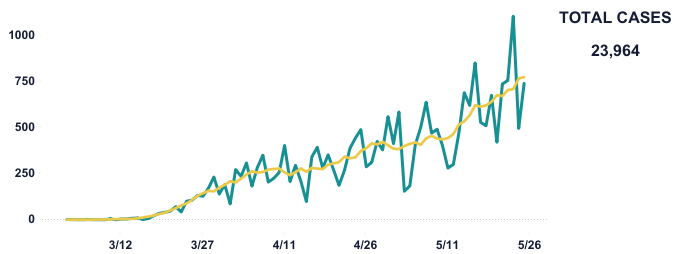On May 23, North Carolina saw a new record single-day increase of COVID-19 cases: 1,107, up from a previous high of 853 cases on May 16. The bump came just one day after restaurants, breweries, personal care services and pools were permitted to reopen at 50% capacity as the state moved into Phase 2 of its three-part reopening plan. “This is a notable and concerning increase,” said Dr. Mandy Cohen, the state’s secretary of health and human services, in a May 23 press release.
But cases are just one aspect of the coronavirus data for North Carolina. Here’s a look at where the latest numbers stand in Buncombe County and across the state.
Case count
From the start of the pandemic through May 25, North Carolina has reported 23,964 lab-confirmed cases of COVID-19 and 754 deaths. Buncombe County accounts for 276 of those cases, as well as 15 deaths.
Across the state’s 18 westernmost counties, there have been 1,299 cases of COVID-19, according to NCDHHS data. Burke, Henderson and Rutherford counties top WNC for the most cases per 10,000 residents at 33, 27 and 25, respectively. Case count is the only metric that the state reports at the county level.
An estimated 51.1% of adults in North Carolina are at higher risk for developing severe COVID-19 based on being 65 years or older, having at least one underlying health condition, or both, according to data from the NC State Center for Health Statistics Behavioral Risk Factors Surveillance System. People with at least one high-risk underlying health condition make up striking percentages of those who had died of the disease as of May 19: 100% of individuals ages 18-24, 54% of those 25-49, 74% of those 50-64 and 70% of those 65 or older.
NCDHHS estimates that 14,954 of the state’s COVID-19 patients, or more than 62%, have recovered. To find this metric, state health officials assumed a median recovery period of 14 days for non-hospitalized patients and 28 days for hospitalized patients.
Percent positive
More testing means more cases of COVID-19 will be diagnosed, Cohen noted during a May 16 press conference. However, she added, the rise in positive cases may also be linked to the statewide easing of restrictions.
To correct for the increase in testing, health officials use the “positivity rate,” or percentage of positive tests out of all tests administered. The World Health Organization recommends that before reopening, states should maintain a rate of positivity at 5% or lower for at least 14 days.

NCDHHS reports that 8% of all tests came back positive on May 24, the latest day for which data is available. The seven-day rolling average aggregated by the state shows the positivity rate trending upward since May 16.
According to national data compiled by the COVID Tracking Project and the Johns Hopkins Coronavirus Resource Center, North Carolina joins 28 other states in exceeding the WHO’s recommended percentage of positive tests.
Hospitalizations and personal protective equipment
As of May 25, 627 COVID-19 patients are hospitalized in North Carolina, with 81% of the state’s hospitals reporting. 75% of the state’s ventilator supply is currently available, and just over 700 intensive care unit beds remain open.
Per statistics updated on May 25, the state has adequate supplies of face shields, gloves and procedure masks to protect frontline health care workers for at least 30 days. Gowns remain hard to source, explained Mike Sprayberry, the state’s director of emergency management, during a May 21 press conference.

Tracing
As of May 20, 152 new contact tracers had been hired through the Carolina Community Tracing Collaborative. Cohen emphasized the need for contact tracers to reflect state demographics during a May 20 press conference, noting that the hiring team focused on bringing on contact tracers from communities especially vulnerable to COVID-19.
NCDHHS and the Carolina Community Tracing Collaborative reported the following demographics for the new contact tracing hires: 29% African American, 13% Hispanic or Latino, 3% American Indian or Alaska Native, 3% Asian, 39% White, 10% two or more races and 10% who didn’t respond. 45% of these contact tracers are bilingual.
In other news:
- Buncombe County and Western North Carolina Community Health Services continue to offer free community-based COVID-19 testing. This week, testing will be able at 52 Coxe Avenue on Tuesday, May 26, from 1-4 p.m.; Sandy Mush Community Center on Wednesday, May 27, from 1-4 p.m.; and Deaverview Community Apartments on Thursday, May 28, from 1-4 p.m. Language translation services will be available at all three locations.
- Asheville will delay reopening three city pools at Recreation Park, Malvern Hill Park and Walton Street Park, as well as Splasheville in Pack Square Park, until at least Wednesday, July 1. City officials are working closely with state and local health officials and will reassess the reopening date later in the summer.
- The Western North Carolina VA Health Care System is coordinating with the Mayo Clinic’s national program for COVID-19 treatment. The program allows plasma from recovered COVID-19 patients to be donated, screened and used for treatment in those who are sick with the coronavirus.
- The Asheville Area Chamber of Commerce has released a Smart Restart Toolkit with guidance for business reopening. Guidance is broken down by industry and includes links to resources such as regional suppliers and Asheville’s ‘We Care’ Stay Safe Pledge.



I heard that officials in Georgia figured out that if you rearrange the order of the days on the chart, it reveals that the covid cases are actually going down! C’mon, sheeple! It’s just another Deep State trick!
#QANON #TRUMP #MAGA #nomasks #maskskill
Actually, you don’t need to rearrange the dates. Just do what the global-warming “skeptics” do: compare the peak right around May 1 with the dip right before May 26 and lol, lefty loons — the cases went down, not up. Obamagate!
It is even more effective when you can forbid the reporting of data completely. Trump supporters have been studying Stalin’s tactics for pointers. #MakeCensorshipGreatAgain #Ignorance=Freedom
But it’s win-win. If we have the most cases, it proves we’re transitioning to greatness again: https://twitter.com/sarahcpr/status/1261085326887604224 .